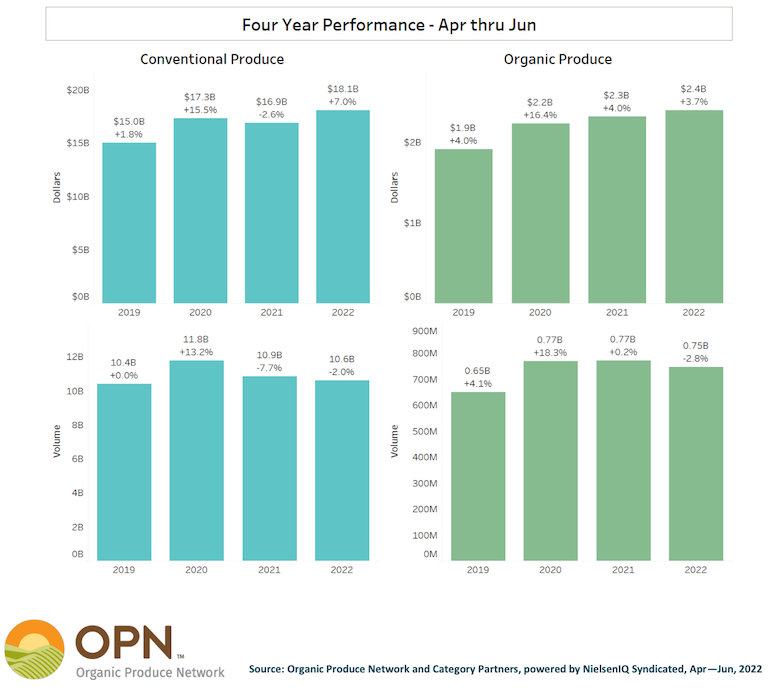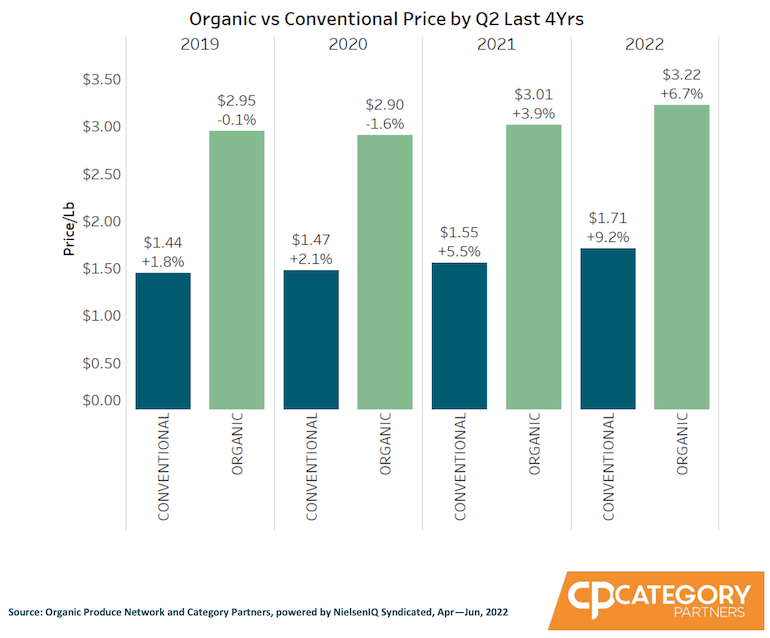Inflation gave a lift to organic fresh produce dollar sales but pinched unit volume in the 2022 second quarter, the Organic Produce Network (OPN) and Category Partners reported.
From April through June, organic fresh produce sales rose 3.7% to $2.4 billion, compared with 4% growth to $2.3 billion in the 2021 second quarter, according to the Q2 2022 Organic Produce Performance Report from OPN and fresh food research and analysis firm Category Partners. Pricing climbed nearly 7% year over year for the 2022 second quarter, contributing to a 2.8% dip in unit sales to 750 million versus a 0.2% uptick to 770 million a year earlier.
The trend was similar for conventional fresh produce, which also felt the impact of inflation. Dollar sales of conventional produce gained 7% to $18.1 billion in Q2 from $16.9 billion in the 2021 quarter, when sales declined 2.6%. Unit volume fell 2% to 10.6 billion in Q2 2022 from 10.9 billion in Q2 2021, which saw units down 7.7%.

Though carrying a lower average price per pound, conventional produce actually experienced a bigger price hike in the second quarter, the OPN/Category Partners report said. Pricing for organic produce rose 6.7% year over year to $3.22 per pound on average in Q2, compared with a 9.2% increase to $1.71 for conventional produce.
The Q2 2022 Organic Produce Performance Report uses NielsenIQ multi-outlet, syndicated data (covering supermarkets, mass merchants, club stores, dollar stores, convenience stores and military commissaries) to track and evaluate the performance of organic fresh produce, specifically the 20 largest organic categories.
OPN and Category Partners said the findings indicate that consumers are keeping a rein on grocery spending, as inflation often has a bigger impact on higher-priced items, such as many organic fresh produce offerings.
“Seeing a decline in organic volume for Q2 suggests food budgets are under stress in many U.S. households,” said Tom Barnes, CEO of Idaho Falls, Idaho-based Category Partners. “It’s common to see budget-centric consumers trade down, substituting for lower-priced conventional items or shifting from a high-priced organic item to a cheaper organic alternative from another category.”

In the 2022 second quarter, 13 of the top 20 organic produce categories generated dollar sales gains, led by tomatoes at +27.1%. Also seeing double-digit dollar-sales growth were onions (+18.1%), grapes (+16.1%) and potatoes (+10.1%). The other organic produce gainers in the quarter were bananas (+8.2%), broccoli (+7.6%), cucumbers (+6.6%), avocados (+6%), berries (+4.3%), carrots (+3.9%), salads (+2.4%), apples (+1.3%), and herbs/spices (+0.7%). Dollar sales fell in citrus (-10.5%), bell peppers (-7%), squash (-6.3%), lettuce (-5.2%), celery (-4%), kale (-2.6%) and mushrooms (-0.3%).
Berries ($434 million) and salads ($390 million) remained the two biggest organic fresh produce categories in Q2, accounting for 39% of total organic produce dollars. In terms of segments, organic blackberries segment had the largest percentage increase, while blueberries saw the biggest decrease.
Meanwhile,15 of the 20 largest organic produce categories posted unit sales declines in the second quarter, pointing to the impact of higher prices, the OPN/Category Partners report said. The unit decreases were led by watermelons (-31.2%), citrus (-19.3%), lettuce (-17.5%), avocados (-13.5%) and bell peppers (-10.2%), followed by celery (-9.9%), apples (-9.6%), squash (-7.4%), salads (-5.5%), broccoli (-3.5%), berries (-2.2%), carrots (-2.1%), herbs/spices (-1%), potatoes (-0.8%) and cabbage (-0.5%).
Unit sales increased in the quarter for tomatoes (+19.3%), grapes (+16%), bananas (+4%), onions (+1.7%) and cucumbers (+0.2%). Also among the exceptions were blackberries, which gained almost the same amount in both dollar (+27.6%) and unit sales (+28%).
According to Barnes, organic substitution by shoppers helped organic bananas achieve a strong Q2 performance.
“Bananas are one of the lowest-priced organic fruits and have the smallest price spread between conventional and organic. For the quarter, while nearly every other organic fruit declined in volume, bananas increased in both dollars (+4.3%) and volume (+4%),” he explained. “So for budget-focused consumers still wanting to buy organic, bananas provided a cost-effective option. Suppliers need to be aware of shifting consumer purchase drivers and develop strategies to keep shoppers buying.”
Matt Seeley, co-founder and CEO of Monterey, Calif.-based OPN, remains upbeat on the long-term prospects for organic fresh produce growth. Still, the OPN/Category Partners report noted that organic suppliers and retailers will need to keep an eye on pricing, since light organic shoppers may be enticed to substitute lower-cost conventional produce for similar, higher-priced organic items. The research shows that while price growth for conventional items is higher by percentages, nominal growth is higher for organic items by 5 cents per pound.
“While there are likely some difficult months ahead, the long-term potential for continued organic fresh produce growth remains unchanged,” Seeley observed. “Inflation and supply chain challenges have impacted pricing in the short term. However, organic fresh produce will remain an important component of weekly food shopping as consumers look for healthy, safe and nutritious products for their families.”
Geographically, all four U.S. regions showed increased dollar sales and declined unit volume for organic fresh produce in the 2022 second quarter. The biggest geographic market, the South ($749.8 million), saw dollar sales rise 5.5% and units decrease 1.3% in Q2, followed by the West ($737.4 million) at +4.9% in dollars and -1.7% in units, the Northeast ($547.1 million) at +0.4% in dollars and -6.1% in units, and the Midwest ($367.7 million) at +2.8% in dollars and -3.7% in units.


